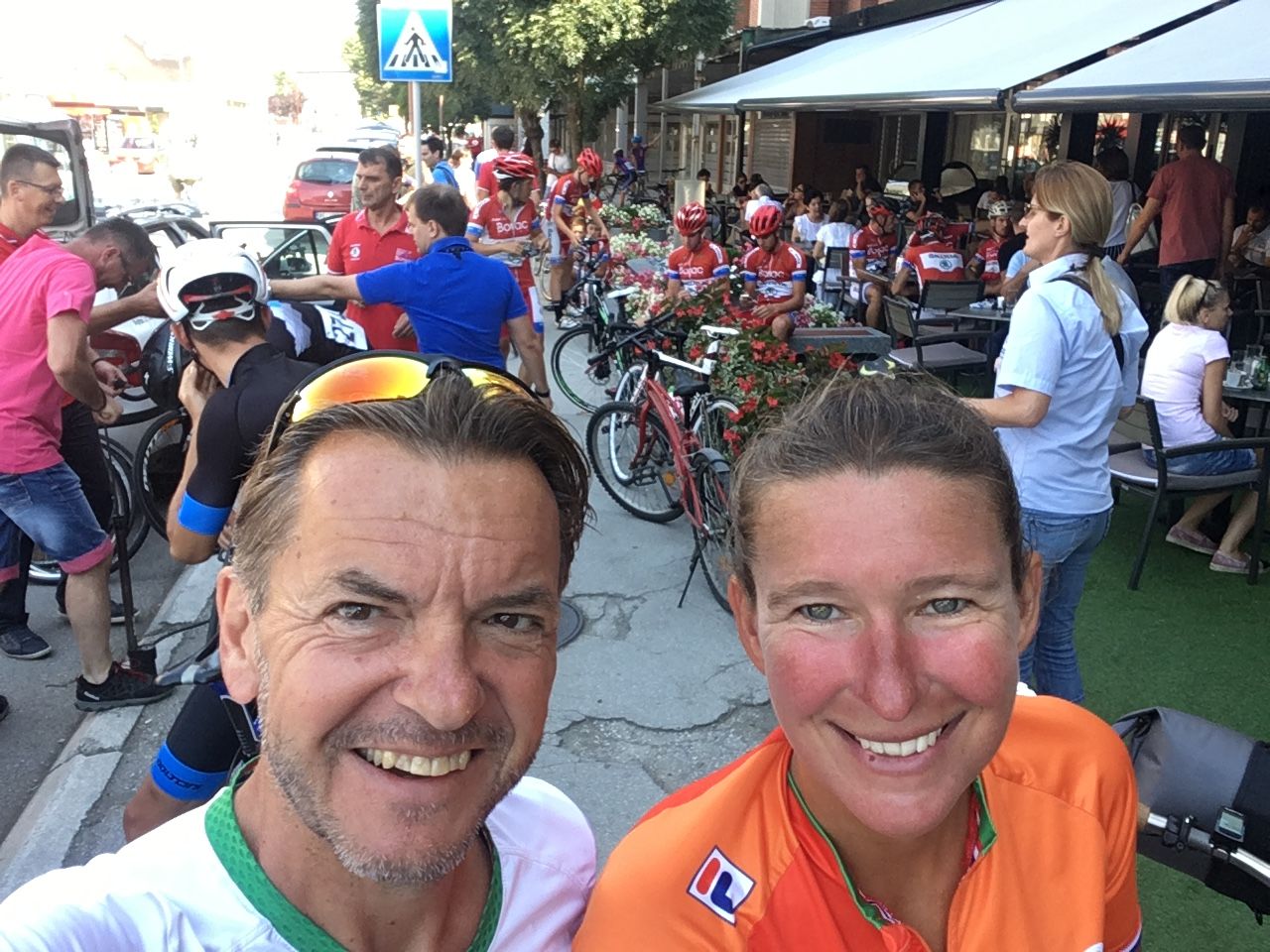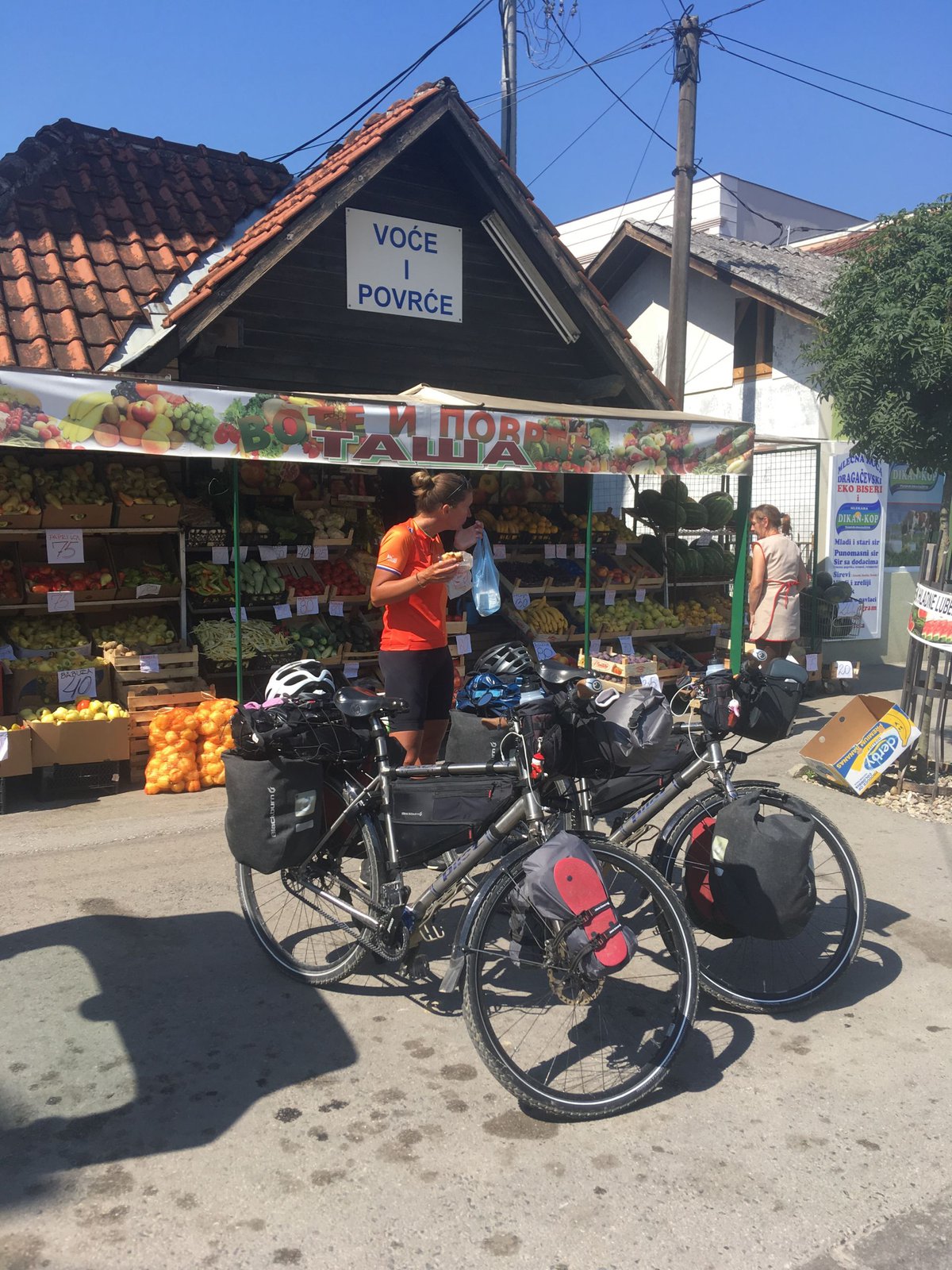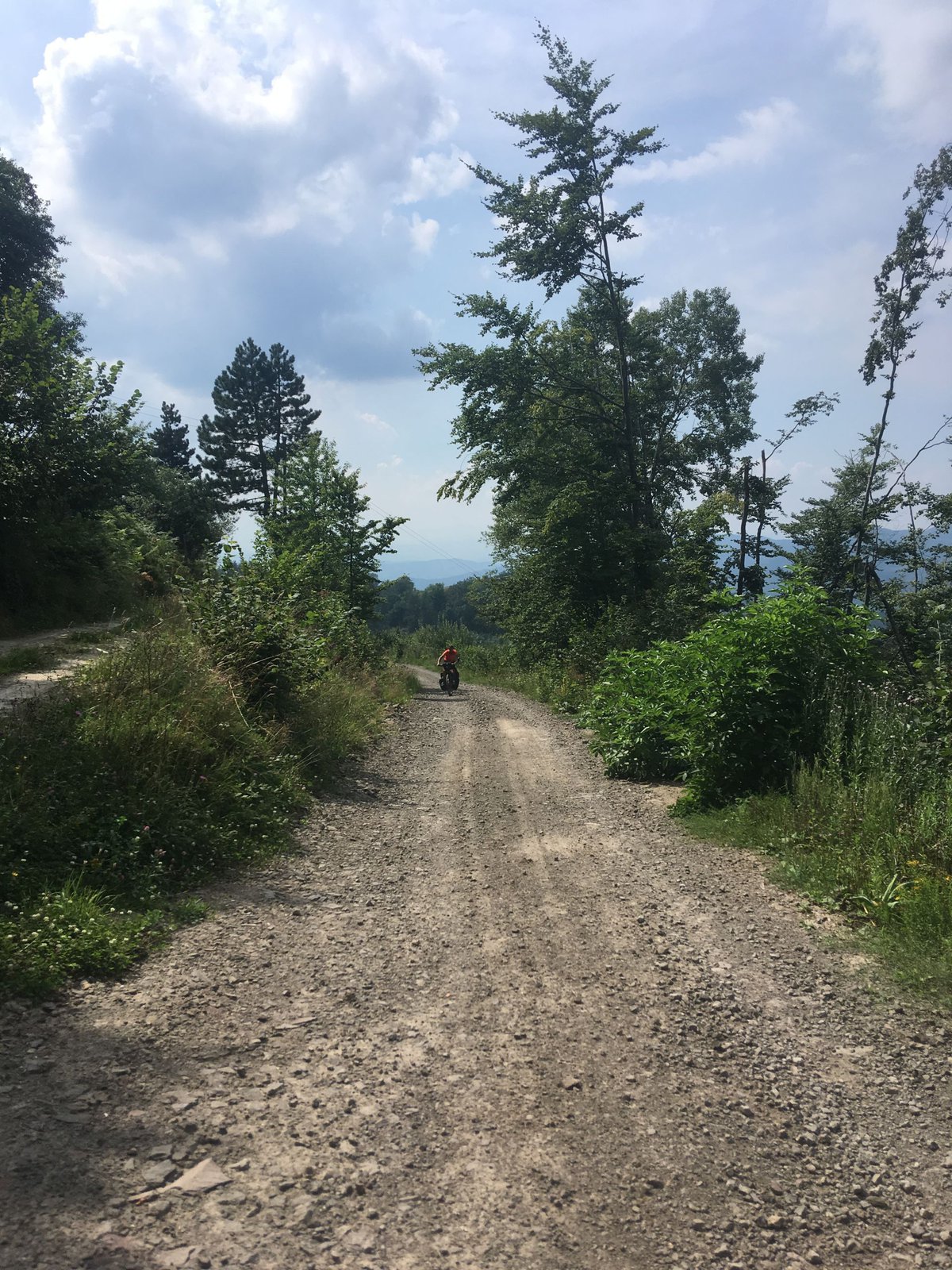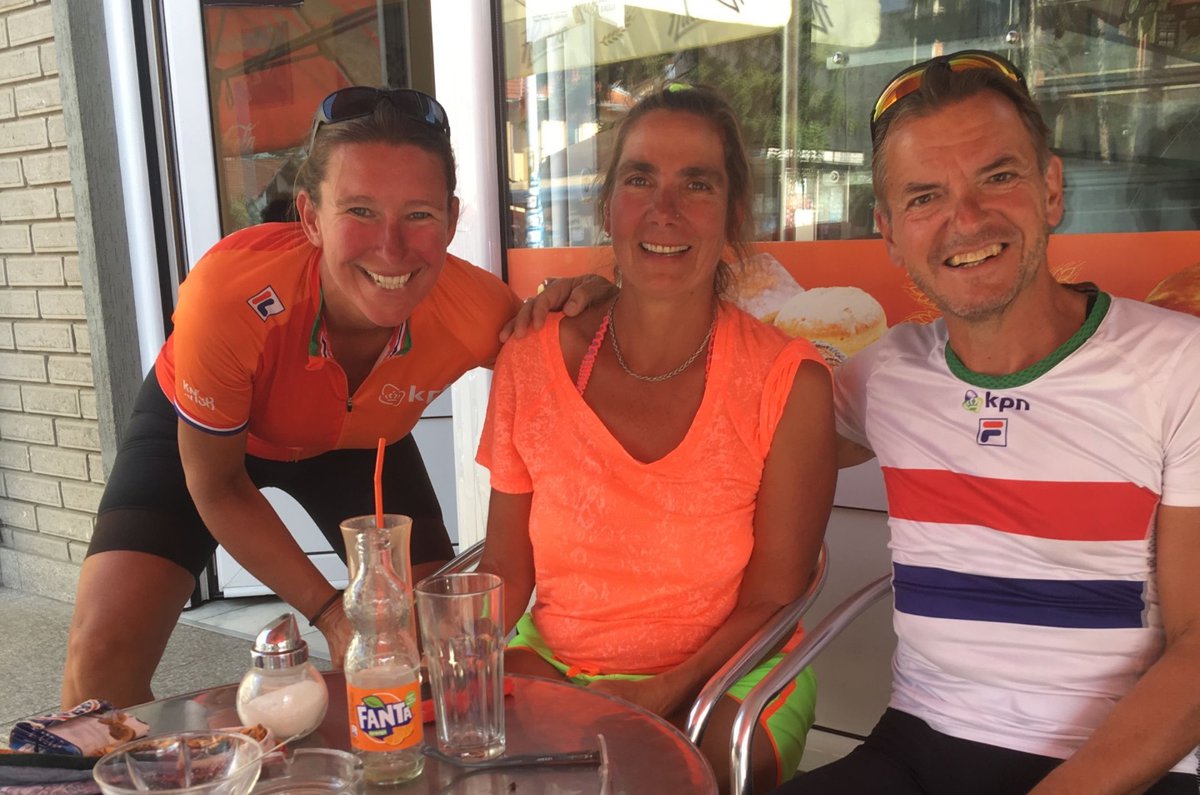
Under an inky dark sky we cross the border to Serbia. We spend the last 15 Bosnian Marks (about € 7.50) on delicacies at a gas station on the Bosnian side. In Bajina Basta we quickly find the tourist information center. Irena is at the desk, answers in fluent English at our questions and makes several phone calls for us. What a nice lady!
Via Maps.me and information gathered on the internet, we had roughly designed a tour of Tara mountains. The area map shows that this route is a good choice. Irena confirms. Campsites are few and they also appear to be closed in general. On the internet we had read that wild camping in the mountains is forbidden, “because of the wild animals”. Irena tells us that this is not completely true: “it’s not probitted, so allowed”. The bears in the area are not numerous and usually do not show up.
In Perucac the campsite appears to be adjacent to a nice restaurant that was built above a river with a waterfall. We are the only ones there. Later an Italian couple with such a cool tent on top of the car arrive and a Slovenian couple with a mini camper van. The Slovenian lady, also called Irena, is impressed with us, cycling all the way from the Netherlands! Soon she brings us prunes from her garden.They live on a farm in western Slovenia and celebrate holidays in the various countries of the former Yugoslavia. When we are in the tent and almost asleep, she offers to make coffee in the morning. We turn it off because we have our own espresso maker, but when it turns out that the new coffee is not suitable for the perculator, we will get back to that offer. Together with the coffee, Irena brings homemade homeopathic ointment against aches and wounds. What a sweet woman!


From the campsite at a height of 240 m to the hamlet of Mitrovac in the central Tara Mountains at 1106 m, we have to climb 866 m in 15 km. A wonderfully moderate and absolutely acceptable climb in percentage. After 2.5 km Roelie remembers something and Harry returns to the campsite to get the power pack and a rear light from the current. Two extra hairpin bends for Harry! The road is beautiful and very quiet: few cars and no motorbikes! Along the way we are treated several times to a beautiful view of the valley of the Drina and the reservoir upstream at Perucac.
Mitrovac appears to be a chaotic collection of holiday homes, apartments, a youth holiday complex, two restaurants and a mini-market . The weather seems very unstable and we ask at the tourist information center about the weather forecast. The lady behind the counter is wise and does not dare to make a prediction.

We cycle that afternoon first on a gravel road to the most famous viewpoint in the park that indeed offers a breathtaking view over the canyons of the Drina. You see here a handful of tourists, even of Asian descent, but there are no queues to take the turn for that one photo, as we have experienced in National Parks in Canada. The way back to Mitrovac gives us some altitude and we get a few groceries before we go to our intended wild camping spot: Lake Zaovine, about 8 km further (and 200 meters lower) into the park. The spot near the Zaovine dam is indescribably beautiful. We put on our swimwear and take a dip in the cool, clear blue water. Afterwards we drink a can of beer and eat potato chips on the pebble beach.
Unfortunately, we there is a thunderstorm coming in soon. We rush to our camp spot. It’s very windy and with some difficulty our tent stands. It also starts to rain and we take our seats and sit in the tent … to get out again after 5 minutes. The weather is very unstable: then the sun shines again and it is warm, then it blows hard again, then the big drizzle rains. The only thing that persists is the thunder in the dark clouds around us. We decide to eat in a restaurant on the other side of the dam. By 8 o’clock we are studying the menu with Serbian dishes. The door of the restaurant is locked after us; in Serbia they eat early. What we want to order from the menu turns out not to be out of stock, in the end there to choose between a Serbian burger and goulash.

The next day, Roelie is not feeling very well. Our goal is the city of Užice, about 70 km away. There would be a campground in the hills outside the city. We get up early; the descent yesterday to the lake, has to be cycled back up. Roelie has a hard time and we are happy when we are back in Mitrovac. From there it is east to Kaluđerske Bare. We stay on average more or less on altitude, but unfortunately the Tara mountains are not a straight plateau. It’s up and down considerably constantly. But what is it beautiful! And what is it quiet! You expect to see a deer (or a brown bear haha) crossing the road at any time.
When we arrive at Kaluđerske Bare, Roelie is exhausted. It is still about 40 km to Užice and we hope it is all downhill. The height profile of maps.me draws us from that dream. At a shop we store some water. Outside we are approached by a kind of bordercontrol-gentleman on a mountainbike. He speaks English well and asks if he can help us with anything. Yes, we want to go to Užice, what is the least strenuous way? We show him our route that goes over gravelroads. “Do not take that way, that’s shit!”, he warns us. He says we have to descend to Kremna and then we can cycle on a more quiet old road or a more busy new road to Užice. Both roads have two more climbs in store for us. Although he lives in Užice, he has never heard of our intended campsite, but according to him there is also a campsite in Kremna. We ask about the possibilities of wild camping, but he did not want to advise us because of his – for us not entirely clear – function.
After 10 km descending we immediately come across a sign: camping Viljamovka 2 km. Roelie indicates that her tank is really empty and that if the campsite looks good, we should spend the night in Kremna. After 500 meters there is a sign: camping Zip 300 meters. Hey wait is not that another camping? Three hundred meters further we are at camping Zip and we meet Ana. The campsite has just opened and is modern, clean and fully equipped, including washing machine and good working wifi. It also has a kitchen with large dining room, not unimportant for cyclists with a small tent and an almost empty gas tank. In addition, the storm threat remains. When we set up our tent and had the laundry done, Roelie collapses. A day later Harry also gets sick, with the same symptoms. Finally we are four days guest of Ana at camping Zip. Ana, the good English speaking hostess, turns out to be an angel: unasked, she is really doing so much for us, it’s too much to mention. We are very happy that we have met her and stayed at her campsite!
After days of rest and Ana’s help, we can continue. An additional advantage is that the weather has also recovered. The thunderstorms stopped and the sky is finally blue again.

You meet few cyclists in Serbia. At least until Čačak. There we see a first one and later a hundred more. There appears to be a tour in the center to start.


Not beautiful, but in our eyes nice cities: Užice, Pozage, Čačak. Many terraces, liveliness, shops, greengrocers and bakeries. But above all there are many mini markets. The ultra tiny supermarkets are everywhere along main roads and in backward villages. In a hamlet there can easily be three in a row and customers come to every one of them. Within the few square feet that the store counts, it is packed full of all kinds of products. Never before the store is missing the refrigerator(s) with various types of pivo (= beer), soda’s and fresh water and a freezer with ice creams. Next to the entrance there is a table with a couch or chairs where you can enjoy the pivo while chatting.
People in Serbia are more enthusiastic when compared to previous countries we have cycled through. From young to old we get a dobar dan (good day), a thumbs up, a voice, a hoot or a ‘bravo!’! Is everything Serbia is good? No, not everything. The verges, but also often riverbeds are full of waste. There is plastic everywhere. Supermarkets overload customers with plastic bags. Empty PET bottles, cans and waste are scattered in roadsides, rivers, villages and meadows. Apart from that Serbia gets a lot of praise from us. The people are very nice, the villages and towns buzz with life in a very relaxed way and nature is beautiful. There is probably a lot more to discover in this country.
After Čačak the valley of the river Zapadna Morava is getting wider and somewhat duller. Even though we cycle far from the main roads, it becomes a bit monotonous. Is this route too flat for us? We are happy if we can leave the valley for our overnight stay and have a tough climb before we enter a modain tourist town. In Vrnjacka Banja, our second Spa / Thermen place where we spend the night after Kremna is crowded, but pleasantly busy. The previous banja (Ovcar Banja) had faded glory of the Yugoslavian era, ut this place has definitely outgrown it and it hot!

Vrnjacka Banja is bustling, probably thanks to the young people who have come to a multi-day festival in the heart of the city. We are tempted to join in, but to worn out to stay up late. At our apartment we see that our original route continues to follow the somewhat dull valley of today. We do not really want that. We prefer to go more to the south, back into the mountains. On Lonely Planet we come across Devil’s Town as a highlight of Southeast Serbia. The route brings us up on a mountain south of Vrnjacka Banja. We climb through the forest towards Mount Goc. The first 10 km we are accompanied by a bunch of small flies that fortunately do not stab but ensure that we on the one hand continuously swinging our face to slap them from our eyes, nose and ears and on the other hand at least increase our speed with one kilometer per hour uphill.
After a wonderful first part of the descent we drive into an increasingly populated part where mainly blackberries are grown. When we lunch with a melon for lunch at a brook, the farmer offers to pick blackberries and eat from his adjacent plot. The blackberries are large and ripe and delicious.
A less inspiring part follows after that valley. Not strange after 60 km of beautiful Serbia. In the somewhat economically backward Blace we see a chic terrace. The hotel is not yet open and would probably have been too expensive, a campground is in this part of Serbia far to seek and there is a lack of puff to find a wild camping spot outside of this city. The waiter tells us that there is a room for little to rent 50 meters away. We order beer and call it a day.
Do you know the story of those cyclists from the Netherlands that went to Devil’s Town? So they did not go. In the town of Kuršumlija we get in to the tourist info center. The four ladies speak almost no word of English, but it becomes clear that we are not allowed to camp at Devil’s Town and the folders show us the previously known pictures of the rock formation. While enjoying a cup of coffee, Harry out of the box drops the idea to leave the extra 500 high climb to Devil’s Town for what it is. The idea eventually finds support.

We cycle past the Devil’s and hope to reach the town of Leskovac. There is a climb of 800 altitude meters but it is still early and we skipped the 500 m climb to Devil’s Town. Maybe we’ll manage. Well in the end we do, but on our teethbones. After Prolem Banjo the climb turns out to be a lousy gravel road with steep parts from time to time. Halfway through, a man living in France for 30 years, invites us for a drink. He has a simple house in Serbia but with 20 hectares and above all with a great view. This year it is already the fourth time that he has returned. A few coke and a schnapps further, we think we should continue. We are still far from the top of this (too) heavy climb.



A kilometer before the summit Roelie speaks for the first time the words ‘I do not like it anymore’ and Harry asks ‘will we try to cycle a bit further?’. The loose stones force us to hike the bike up the hill. Even the feet often shoot away. No grip. A hell of a job that we do not finish until well into the afternoon.
The valley at the other side of the hill shows a very different Serbia. We see people with a much darker skin color, shabby houses and the usual shops and terraces are missing. In Bojniks we want to stop cycling, but there is no fine vibe. There is also an incredible amount of police around. Going on to Leskovac! Leskovac appears to be a surprisingly lively and organized town. On the 22 kilometers to there we meet cyclists, mountain bikers and cyclists. In the central park we find a hip terrace. In the evening we order a well deserved plate of pasta (Roelie) and a big pizza (Harry).
The next morning we cycle a boring stretch to Vlasotince, but from there the route is fortunately better. We take it easy today (at least that was the intention …). Yesterday’s stage was tough and Harry also slept badly due to abdominal pain. At Babusnica a beautiful gorge ends in to a wide open valley. It is hot today and we want to sit in the shade for a long time to cycle to Pirot. On the main road we see a well-known bamboo bike. Throughout Serbia, but also in Slovenia, Croatia and Bosnia-Herzegovina, we have not seen a cyclist with gear, but here Audi is sipping an iced coffee. Audi stayed with us in Oirschot as a Warmshowers guest on her way to Morocco earlier this year. What an incredibly coincidence! Audi is also the one who advised us to cycle through Serbia instead of Romania. A good tip that we can personally thank her for. She gives us another tip: not to cycle to the city of Pirot but to Zvonce.

We start climbing around 16 hours for another 25 kilometers to Zvonce. This is a tough stage again. It is after 7 pm as we are looking for a spot to camp along the river Jerma. However, the river is still a meters below us and has no flat banks. Suddenly we see a group of cabins … It’s already starting to twilight … It’s kind of cold … The cabins have warm showers … And a restaurant … Harry’s stomach has been protesting all day. Will this be the last night in Serbia? That will be it a nice last night in Serbia. And last but not least: we descend through a extraordinary wonderful gorge of the river Jerma, an absolute highlight of the route through Serbia.


With a minor headwind we cycle to the border of Bulgaria. We realize that from Oirschot we have had the wind in our back. A big contrast with the Great Divide MountainBike Route last year where we had three months of mostly strong headwinds. What will Bulgaria bring us? We will write about it later!